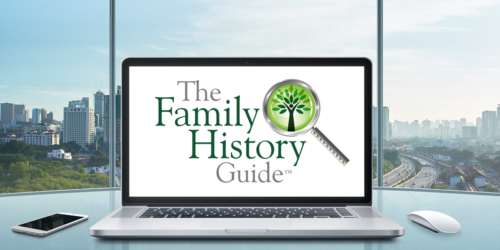12 Ways to Get Started with Family History
One of the most common questions people ask about family history is, “Where do I start?” There is so much information about family

history the web that it can be a real challenge to sift through it and know where to begin.
The Introduction section of The Family History Guide provides some good suggestions, but there are also quite a few activities in the Projects section that beginners can tackle, to get that “sense of accomplishment” going.
Here are 12 activities from The Family History Guide that can help you, a friend, or a family member get started with your family history. In the examples below, links are provided for FamilySearch Projects in The Family History Guide; similar links are also available for Ancestry, MyHeritage, and Findmypast Projects in the top menu.
1. Learn the terminology. Understanding the basic words and concepts for family history will get you off to a better start and help you absorb articles and videos more easily.
2. Get an account and log in on one of the main platforms—FamilySearch, Ancestry, MyHeritage, or Findmypast. FamilySearch is free, and basic or trial versions of the other platforms are available at no charge.
3. Build and navigate your tree. If needed, add basic information from a couple of generations, based on what you know. Then you can begin researching or linking to other ancestors in your online tree.
4. Explore The Family History Guide. Regularly spending 15-30 minutes a week on instructions, articles, and videos in The Family History Guide can prime you for success.
5. Gather family records. Collect your own records, and then reach out to family members such as siblings, aunts, uncles, and cousins for more. These records can provide vital research clues, as well as source documentation for your existing tree.
6. Organize photos and documents of your ancestors. Gather what you have, and then seek out additional photos and documents from other relatives.
7. Interview living relatives. This is vital but often overlooked or postponed. Capture memories and facts from family members while the opportunity is there. You’ll build relationships while building your family tree.
8. Upload photos, stories, and documents. Sharing them with other people who have access to your tree can be valuable in a number of ways, and you’ll see plenty of photos and documents that are new to you, shared by others. You may even discover cousins or other relatives you never knew about.
9. Organize your research materials. The better organized you are, the less time you will lose duplicating steps you’ve already takesn, or searching again for facts that were once at your fingertips.
10. Get help with your family history. Help is available at family history centers, in Facebook groups, and websites like Random Acts of Genealogical Kindness.
11. Learn the basics of doing research. Get off to a good start. A strong foundation will support your ongoing research and eliminate frustration along the way.
12. Get started with indexing. This provides help to others who are doing research, and it can be a great complement to your research activities.
If you need help with basic computer skills for family history, be sure to check out Computer Basics in the Introduction menu.





